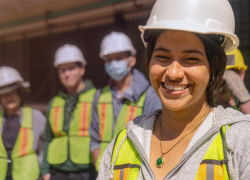
Unprecedented federal investments in infrastructure, clean energy, manufacturing and technology are poised to improve life for individuals and families across America. Many have asked, will we have a trained workforce available to do all of this?
A big part of the answer depends on our nation’s workforce development system. The Workforce Innovation and Opportunity Act provides $3.6 billion a year for that system. Most of that money — $2.9 billion — is given to states in formula funds. This system is essential infrastructure, too — the roads and bridges that connect people to the good jobs they want and need, and employers to the people they want and need.
For our economy and communities to thrive, we need these workforce development roads and bridges to be as strong as the rest of the country’s infrastructure. But like physical roads and bridges, there are potholes and cracks. And there are entire communities — often poor, of color, immigrant — that aren’t served well by them. The system doesn’t work for everyone. This is our chance to make sure it does.
Yet from my experience working in state government, and in my travels as deputy -secretary, I know that too often, there is a feeling that WIOA, and we here at the department, can be too rigid for bold, innovative thinking. But that’s simply not the case under the Biden-Harris administration. Secretary Walsh and I are focused on unleashing the power of the Department of Labor to pursue bold and innovative actions to strengthen our workforce infrastructure, while centering equity in everything we do.
For far too long, even when our economy was at its most prosperous, that prosperity has not been shared equitably. We must look at how our programs and policies may be perpetuating systemic barriers, and then take the requisite steps to address and remove those barriers. Doing so will position our workforce system to be a powerful tool for connecting under-resourced and underrepresented workers and communities to good jobs created by a generational investment in our nation.
For me, this starts with Black workers, who by almost every measure experience some of the greatest inequities. For example, Black participants in WIOA-funded programs systematically land in jobs where they are paid less than their white counterparts. Not only were Black workers more likely to be unemployed during the pandemic and much less likely to be getting unemployment benefits, but Black workers also experience higher rates of long-term unemployment than white workers, suggesting that the workforce system needs to do more to help Black job seekers reconnect to employment and good jobs.
To fix the problems with our workforce infrastructure, we need innovative and bold action. The department is committed to resetting and strengthening our federal-state-local partnership, so that workers from underserved communities get good jobs free from discrimination with family sustaining wages, benefits and the right to organize and join a union.
As part of this reset, we are committed to encouraging and supporting state and local leaders to:
-
Help build and invest in sector-based labor-management partnerships that result in effective training programs tied to quality jobs.
-
Integrate job quality and equity requirements in programs and grants, so resources target communities where workers face the greatest barriers to good jobs.
-
Provide access to supportive services, from care to transportation and more, to enhance workers’ opportunities for growth and success.
-
Measure success not just by if a worker gets a job, but whether the most vulnerable workers get connected to good jobs.
Unfortunately, myths surrounding WIOA abound, some that have been around for years, and have taken on the force of law about what WIOA supposedly requires and allows.
That is why the department is developing a campaign to dispel the myths. It’s called Yes, WIOA Can!
The Yes, WIOA Can! campaign will provide information on how WIOA can be used to further innovation, equity and job quality. We will share local and state examples of how workforce partners are leveraging those flexibilities to achieve big things and drive equitable outcomes. Above all, we here at the department are excited to work with local workforce boards, state workforce leaders, workers and worker organizations, labor management partnerships, employers, industry associations, and community-based organizations to unleash the full power of WIOA to connect people to good jobs and employers to workers who are equipped with the tools and skills needed.
It is through the ingenuity, talent and work ethic of workers in every community that dollars will be transformed into new roads, safe bridges, reliable internet, electric vehicles and semiconductors, pipes that carry clean water, and electric batteries that will power our future. We invite you to partner with us on showing what true innovation and opportunity look like in developing the workforce of America.
Yes, WIOA can help build a strong, resilient economy where no one is left behind.
Julie Su is the deputy secretary of labor.

 U.S. Department of Labor Blog
U.S. Department of Labor Blog
